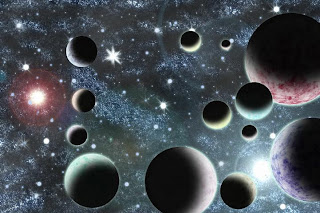
We can define astronomy as the science which investigates all the matter-energy in the universe its distribution, composition, physical states, movements, and evolution. Astronomy is one of the oldest sciences. It is the scientific study of stars, planets, comets, nebula, star clusters and galaxies and phenomena that originate outside the Earth's atmosphere. And also as we mentioned above it is concerned with the evolution, physics, chemistry, meteorology, and motion of celestial objects, as well as the formation and development of the universe.
Methodical observations of the night sky and astronomical artifacts have been found from much earlier periods. However, the invention of the telescope was required before astronomy was able to develop into a modern science. Since the 20th century, the field of astronomy spread over observational and theoretical branches.

It is built on Greek root astron = star and nomos = arrangement, order or law. Astronomy, therefore, is the study of arrangement of stars. It is the branch of Physics that studies celestial bodies and the Universe as a whole. Origin of the universe : The Big Bang, that gigantic explosion occurred some 15 billion years ago, is not only the beginning of our own Universe, space, matter and time, but also the generator of all mass. This mass of interstellar cloud of dust and gas (solar nebula) collapsed under its own gravity. The result is, this collapse of molecular clouds vaporized the dusts and the fireball expanded, cooled and compressed in the middle and developed into a Protostar, leaving the rest of the gas to rotate around it. This cooling effect generated the most basic elements, hydrogen and helium. In due course most of the gases orbiting the forming star flowed inwards towards the star and became part and parcel of it. However, the gases are rotating and therefore due to centrifugal force some of the gases stayed away from the forming star and formed a disc capable of building itself naturally around the forming star. This disc gives away its energy through radiation and cools off into metals, rocks and ice. The dust particles collide and generate bigger particles and this process goes on till the particle builds into the size of a small rocky boulder known as asteroids. Once the bigger of these particles become really large enough to have its own gravity, the growth zooms! Because of gravity, they absorb smaller particles in their orbit and grow substantially. This process, after millions of years got us 10 or more planets in regular habits forming the solar system.

We live on a tiny blue planet, one of nine worlds that orbit an average-size star called the Sun. Our Sun and its family of planets exist within a vast group of stars called a galaxy. Our galaxy is called the Milky Way, and it contains nearly 200 billion stars-that's about the same number as there are grains of sand on a beach.
Have you ever looked at the night sky and wondered about your place in the universe? This will help you get a little idea about it. Find out where we are and where we're headed. Learn about Earth and our solar system, plus some of the secrets astronomers have uncovered about the stars, galaxies and universe.
No comments:
Post a Comment